Stable in yield and disease-resistant tomato “Sugar Bison”: characteristics and description of the variety
Sugar bison tomatoes are distinguished by good yield, large fruit, taste and a heart-shaped shape loved by Russian farmers. The fruits are universal in use.
In the article we will give characteristics and descriptions of the variety, as well as recommendations from experienced summer residents on growing tomatoes in greenhouses and open ground.
Description
The originator of the variety is the breeders of the Moscow agricultural company "Aelita". The company appeared on the market in 1989. Over the years, the assortment of the agricultural company has increased to 3,500 types of varietal and hybrid seeds of vegetable and flower crops of its own, domestic and foreign selection.

Testing of the variety began in 2013, and already in 2015 the tomato was included in State Register of the Russian Federation. Seed producers recommend the variety for cultivation in all regions of the country in open ground and greenhouses.
Distinctive features
Indeterminate mid-early variety. Bush height – 150-180 cm, the fruits reach the stage of technical maturity in 110 days. The trunk is sparsely leafy. The leaves are dark green, increased in length, and have short fluff.
The first flowers appear after the seventh leaf rosette, then after every pair of leaves. Five fruits are borne on one cluster.
Fruit characteristics, yield
The fruits are round with a sharp tip, shaped like a heart.. When biological maturity is reached on green tomatoes, a dark spot forms at the stalk; at the technical stage it disappears, the fruits acquire a dark pink or crimson hue.
Other qualities of Sugar bison tomatoes:
- fleshy juicy medium-dense pulp;
- the skin is dense, smooth, ribbed;
- number of seed chambers 6-12;
- delicate sweet taste;
- weight – 200-250 g (fruits on the lower branches are larger – 350 g).
Subject to the rules of agricultural technology from 1 sq. m harvest 8-10 kg.
How to grow seedlings
Seeds for seedlings are sown 60-65 days before transplanting into the ground. In central Russia for film and glass shelters - in early-mid March, for open ground - in late March-early April.
Read also:
Advantages and disadvantages of the Raspberry Elephant variety
Seed preparation
Standard preparation of seed material includes seven stages: calibration, heating, disinfection, bubbling, soaking, hardening and germination. Experienced tomato growers begin preparation a month before sowing:
- Calibration. The most viable seeds are selected: large, smooth, not empty to the touch, the rest are thrown away. Prepare a salt solution (one tablespoon of salt per 1 glass of water). The seeds are placed in salted liquid for 15-20 minutes. The seeds that have sunk to the bottom of the glass are selected for planting.
- Warming up. A bag or envelope is made of cotton fabric and the seeds are placed in it. Then they hang it from the central heating radiator. The duration of the procedure is from two to three weeks. A faster way is to spread the seeds on cotton material and cardboard, place the cardboard on the battery for 1.5-2 days.
- Disinfection. Prepare a solution of potassium permanganate: add 1 g of potassium permanganate to 100 ml of water. Accuracy of measurements is important: if you make a mistake in the concentration, you can burn the seeds or not disinfect them. Summer residents use scales. If this is not possible, measure potassium permanganate using a teaspoon. It holds 6 g of substance. This amount is enough for 3 glasses of water. The duration of the procedure is 20 minutes. After disinfection, the seeds are washed with running water.
- Bubbling. The seeds are placed in warm water (+26 - +30 degrees), and stirred every hour for 15-18 hours. Summer residents recommend using an aquarium compressor to saturate the seeds with oxygen.
- Soak. The seeds are placed in warm water or a solution of biostimulating preparations. Russian gardeners usually use Zircon, Epin, and Immunocytophyte.
- Hardening. The seeds are wrapped in cotton cloth and cling film and placed in a cold place (-2... +3 °C). After 8 hours, take it out into the heat (+21… +25°C) for 8 hours. The change in temperature conditions is repeated 5-6 times.
- Germination. The grains are poured onto cotton cloth or gauze. Water is poured into a flat dish and a cloth with seeds is laid out on it. The fabric is constantly moistened until embryos 2-3 mm in size appear on the seeds. Use water at a temperature of +26… +30°C.

Container and soil
Containers for seedlings are bought in the store. There is a lot of choice:
- paper honeycomb;
- peat pots;
- peat tablets;
- peat cassettes;
- PVC and polystyrene cassettes.
Some summer residents choose containers made from scrap materials:
- cups of yogurt, sour cream, curds;
- cut foil packaging for juices and dairy products;
- cut plastic bottles;
- cups from old newspapers;
- egg packaging.
Advice. To make a glass from newspaper, take a glass bottle and wrap it with a strip of newsprint (15*30 cm). Leave a small allowance at the bottom to fold the bottom. The edges are secured with a paper clip, glue or tape.
For Sugar Bison, choose a universal tomato soil mixture, which includes humus, peat and river sand. To prepare the soil yourself, mix soil from your summer cottage, peat with an acidity of pH 6.5, river sand, humus or sifted mature compost in a ratio of 1:2:0.5:1.
Containers and soil are disinfected boiling water or a solution of potassium permanganate. Containers and self-prepared soil are disinfected with boiling water or a solution of potassium permanganate.

Sowing
Seeds are dropped 1-2 cm. Water the ground with a spoon or sprayer so as not to wash out the seeds. The containers are covered with film (a plastic bag or cling film) to create a “greenhouse” effect. The temperature in the room where the containers are kept is +22°C.
Growing and care
As soon as sprouts appear from the ground, the containers are opened. After the appearance of two true leaves (the first pair after the cotyledons), the plants are picked and planted in separate containers. The cotyledon leaves should be near the soil.
At this stage, they begin to fertilize the tomatoes.: mineral fertilizers are added to the soil mixture for seedlings at the rate of 1 tbsp. l. for 5 liters of soil. Two weeks after picking, complex fertilizer is applied.
Watering the plants using a spoon or syringe under the root as the soil dries. To prevent weak bushes from being affected by fungal diseases, prevent moisture from getting on the stem and leaves.
They begin to harden off the seedlings at the age of 40-45 days. At first, they take it outside for 2-4 hours. Two days before transplanting into the garden, the plants are left outside overnight.
How to grow tomatoes
The seedlings are transplanted into the beds after 60-65 days after the first shoots appear. The optimum temperature is +16 °C during the day, +10 °C at night. Transplantation is carried out at the end of May or beginning of June.
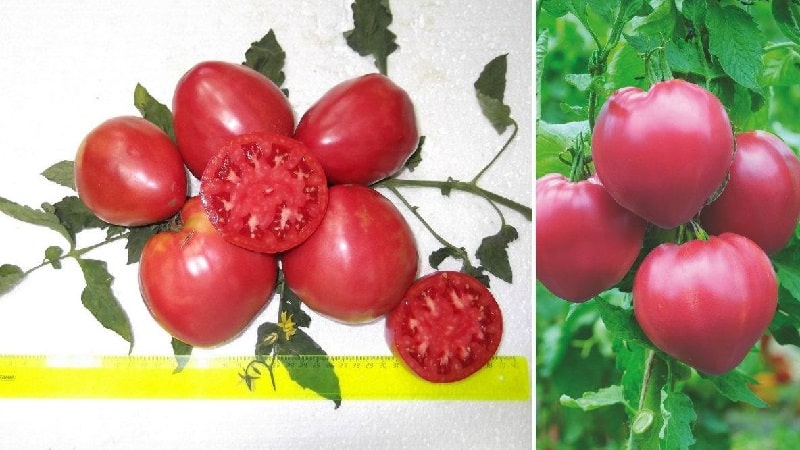
Landing
Tomatoes are planted according to the 50*60 pattern (3-4 bushes per 1 m²). 2 days before transplanting, the seedlings are watered, and the area where the tomatoes are planted is dug up. Cucumbers, zucchini, dill and carrots will be good predecessors for tomatoes, but in the area where tomatoes, potatoes and peppers grew, tomatoes are not planted - the plants are susceptible to the same diseases and suffer from the same harmful insects.
Before planting, the soil is disinfected with boiling water. or a solution of potassium permanganate. After 4-5 days, the bushes are tied up for the first time.
More about large-fruited tomatoes:
Tomato “Big Momma” and the secrets of growing large fruits
Tomato Bull's heart, characteristics and description of the variety
Care
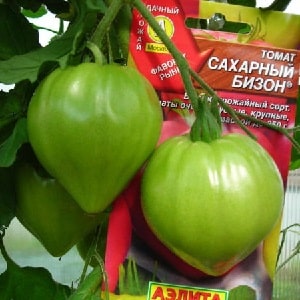 Plants are watered with warm, settled water strictly at the root, avoiding moisture getting on the stem and leaves.. Sugar bison is not a moisture-loving variety, so it is better to underwater tomatoes than to overwater them.
Plants are watered with warm, settled water strictly at the root, avoiding moisture getting on the stem and leaves.. Sugar bison is not a moisture-loving variety, so it is better to underwater tomatoes than to overwater them.
To prevent the sun's rays from leaving burns on the leaf blades, water the tomatoes in the evening or early in the morning. After watering, the plants are immediately earthed up, weeds are removed from around them and the soil is loosened. As soon as the first ovaries form on the tomatoes, loosening and hilling is reduced to 1-2 times every two weeks.
Depending on the growth phase, tomatoes need different feedings.. Nitrogen fertilizers are applied when the bush grows green mass and inflorescences form.Phosphorus-potassium - when the ovary forms on the bushes and the fruits grow. Fertilizing is applied every 12-14 days.
The variety is indeterminate, which means that the bush is not limited in growth. It is pinched when it reaches a height of 1.5-1.8 m, so that the upper fruits have time to ripen before the onset of frost. The plant is formed into one stem. The remaining stems and stepsons are removed.
Important! Stepchildren are removed by hand. When using a knife or blade, there is a risk of transferring an infection or fungus from bush to bush, which is still invisible to the human eye. If using a knife, the blade is disinfected after each plant.
Some summer residents form Sugar bison into two stems. The photo below shows the shaping of an indeterminate tomato.
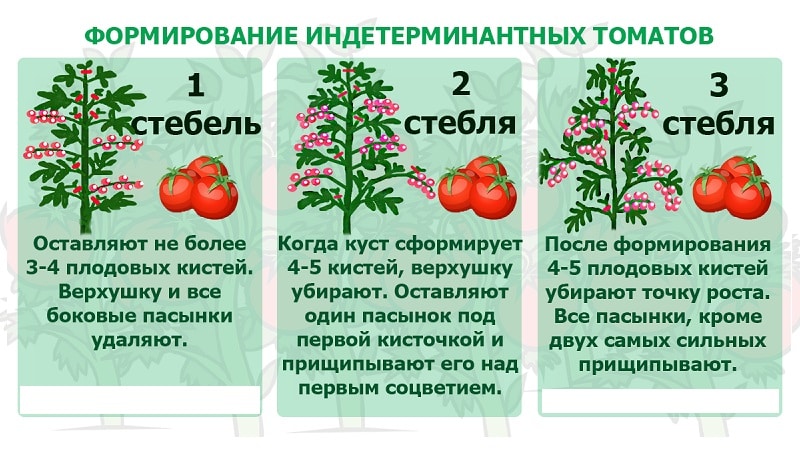
So that tall bushes do not bend to the ground and did not break under the weight of green mass and fruits, tomatoes are regularly tied up as they grow.
Features of cultivation and possible difficulties
When growing Sugar Bison tomatoes, a novice gardener may encounter a number of difficulties. The list contains the main ones and ways to solve them:
- When a large amount of greenery forms on the plant, the fruits become smaller and ripen slowly - as the tomato grows, the lower foliage is torn off.
- Tomatoes do not tolerate excess moisture well, but need regular watering - reduce the amount of watering without harming the plants by mulching the soil with peat, dry straw or grass.
- Tomatoes ripen at a lighter weight than the manufacturer claims - remove excess ovaries, leaving up to 3-4 inflorescences on one bunch.
Diseases and pests
Manufacturers do not provide information about the immune system on packaging tomatoes Sugar bison.But experienced summer residents still carry out preventive measures against common tomato diseases and harmful insects.
 Tomatoes develop fungal diseases in greenhouses. To avoid this, gardeners carefully ventilate the shelters, and treat the plants with the following preparations:
Tomatoes develop fungal diseases in greenhouses. To avoid this, gardeners carefully ventilate the shelters, and treat the plants with the following preparations:
- «Fitosporin»;
- "Ekosilom";
- "Quadris";
- "Ridomil Gold".
Having discovered brown rot on tomatoes, affected tomatoes are removed, nitrogen fertilizing and watering are reduced.
Plantings are attacked by harmful insects such as aphids and thrips. They are fought with the help of the drug “Zubr”. “Prestige” will save you from the Colorado potato beetle, and “Confidor” from the whitefly.
Advice. The smell of nasturtium or marigold repels many harmful insects, so these flowers are planted near tomatoes.
The nuances of growing in open ground and in a greenhouse
Tomatoes of this variety are planted in open ground only in regions with hot climates.. Sub-zero temperatures during spring frosts (often occurring in central Russia and the north) can destroy both recently planted young seedlings and already grown bushes.
In such regions, Sugar bison is grown in greenhouses made of glass, film, and polycarbonate.
Harvesting and application
The fruits are harvested on day 110-115. Used fresh for making salads and sandwiches. Canned - for storing juices, sauces, pastes, snacks and lecho for the winter. They are not used for whole-fruit canning due to the large fruits.
With careful handling, it can be stored for a long time, but does not tolerate transportation well. – the skin of fully ripened fruits cracks. To avoid this, the fruit should be removed from the bush before its technical maturity.
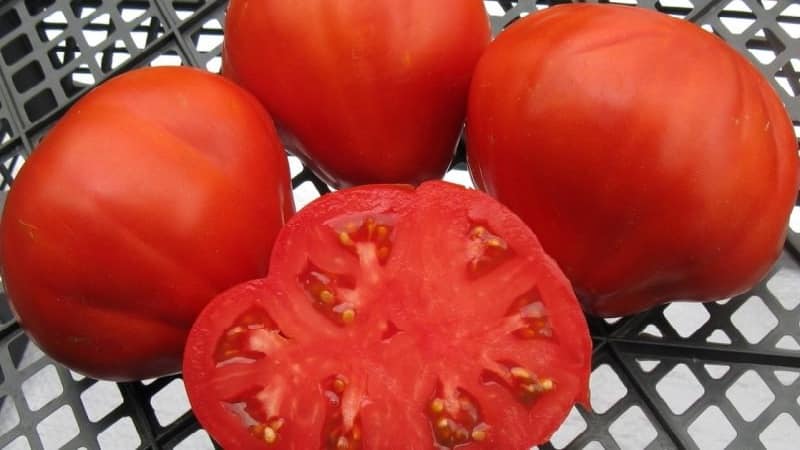
Advantages and disadvantages of the variety
Among the main advantages of this variety are::
- good seed germination;
- high yield (8-10 kg per 1 m²);
- uniform growth and ripening of the fetus;
- drought resistance;
- good keeping quality of fruits;
- excellent taste.
The disadvantages include the need for molding, pinching and gartering, as well as a decrease in yield when grown in open ground.
Farmer reviews
Reviews about the yield of Sugar Bison tomato are positive. Gardeners who grew this variety were satisfied with the harvest and will grow it again.
Pavel, Chelyabinsk: “At the dacha I grow several varieties of bison. I have both Yellow and Black, this year Sugar appeared. I really like all the varieties. The fruits are tasty and beautiful. Plants do not get sick and respond well to fertilizing. The harvest is decent, so there is no need to plant a lot of bushes. This reduces the time required for care. I am very pleased with my choice".
Alina, Samara: “For the third year now I have been planting the Sugar Bison tomato variety, and I am very pleased with the harvest. Tomatoes are sweet and sugary, that’s why I like them. Their color is crimson-red. To make the seeds swell, I soak them in a weak solution of potassium permanganate before planting. This method can also be used for disinfection. The first shoots already appear on the 6-7th day. We eat tomatoes fresh, and this variety also produces very tasty adjika with horseradish.”.
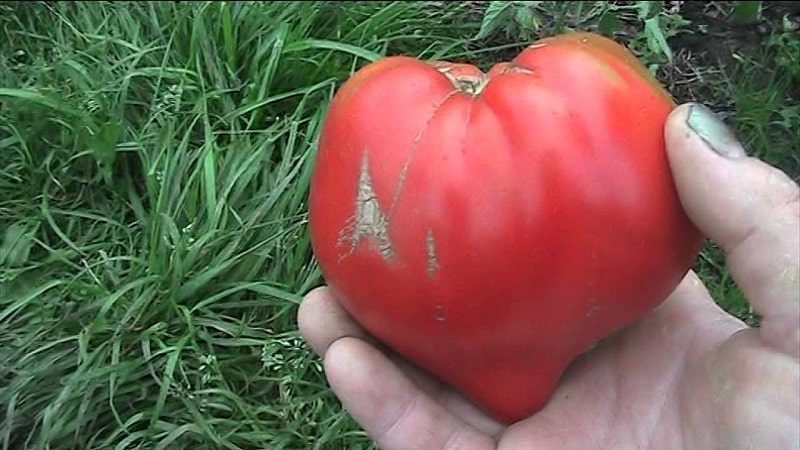
Antonina, Zadonsk: “I’ve been growing it in a greenhouse for three years now. Seed germination is excellent, seedlings grow strong. But in the first year I ran into trouble - late blight attacked. I had to dig up a couple of bushes altogether. Now I always treat all tomatoes with Fitosporin. The tomatoes themselves are beautiful to look at, and the taste is simply fabulous!”.
Conclusion
Despite the fact that the originators recommend tomatoes for cultivation in all climatic zones, when choosing a variety, it is worth considering that in cold regions in open ground the yield will be low.
Otherwise, caring for tomatoes is usual: they are formed into 1-2 stems, the shoots are regularly removed and tied up. Tomatoes are unpretentious to moisture, and can more easily tolerate a lack of liquid than an excess. The variety needs preventive treatment against fungal diseases and harmful insects. The fruits are used both fresh and canned.